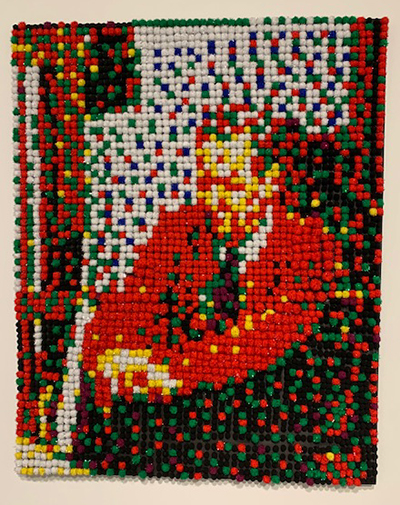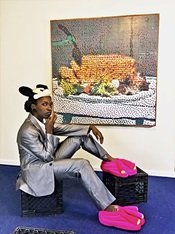Erykah Townsend (b.1997)
It Was a Beautiful Day in the Neighborhood, 2019
Materials: Acrylic, pom-poms on wood panel, 44” x 36”
Location at Summa Health: Dr. Gary B. and Pamela S. Williams Tower, Akron Campus (141 N. Forge St.), Blue Neighborhood, Fourth Floor, Outside Patient Rooms H4-125 and H4-126
Acquired by Summa Health with a donation from the Haslinger Family Foundation
About the Art

Erykah Townsend’s It Was a Beautiful Day in the Neighborhood is a vibrant and playful portrait of Fred Rogers, an enduring symbol of kindness, patience, and learning for generations of television viewers. Created using hundreds of small, sparkly pom poms, Townsend’s work invites interaction: at close range, the materials dominate, appearing as colorful clusters, but from a few steps back, the familiar red sweater and gentle presence of Mr. Rogers emerge.
Townsend’s choice of pom poms is both humorous and conceptually rich. These inexpensive craft store materials echo the accessible, welcoming spirit of Rogers himself while also referencing a classic art historical technique, pointillism. Much like the 19th century pointillist painters who arranged individual dots of pure color to form images when viewed from a distance, Townsend carefully assembles her pom poms so that their colors blend in the eye of the viewer. The effect recalls the early days of television when cathode ray tubes created images by illuminating tiny points of light, making her technique a fitting nod to the medium that brought Mr. Rogers into millions of homes.
The process behind It Was a Beautiful Day in the Neighborhood is as meticulous as it is playful. Townsend first determines the precise number and placement of pom poms needed to replicate her reference image, but the final application is done entirely by hand, making each piece unique. The portrait’s warm colors and unexpected materials invite curiosity while its subject evokes nostalgia, comfort, and a sense of calm. These are qualities that resonate within a healthcare setting.
About the Artist

A Cleveland native, Erykah Townsend demonstrated an early passion for visual art, initially exploring computer animation before transitioning to fine art. She attended the Cleveland School of the Arts from sixth grade onward and in 2015 became the first recipient of a full scholarship for a Cleveland high school graduate to attend the Cleveland Institute of Art, where she earned her B.F.A. in 2020.
Townsend describes herself as a conceptual artist deeply engaged with the intersection of pop culture, memory, and media. Her work frequently reimagines beloved characters from children’s television such as SpongeBob SquarePants, Big Bird, and Tom and Jerry, exploring their broader cultural significance through techniques that blur the boundaries between painting and sculpture. By layering digital and handcrafted processes, she creates works that are at once familiar and surreal, playful and thought provoking.
For Townsend, art is not only a visual experience but also an intellectual and emotional one. She seeks to create moments of distance and perspective, encouraging viewers to reconsider everyday imagery in new and unexpected ways. At Summa Health, It Was a Beautiful Day in the Neighborhood offers a moment of joy, curiosity, and warmth. These are qualities that define both the artist’s approach and the legacy of Fred Rogers himself.
Where You Can See More of Townsend’s Work
Townsend’s work has been featured in exhibitions at the Reinberger Gallery and Newsense Gallery. Her website showcases additional examples of her distinctive, humor-infused style, which often critiques consumer culture while celebrating the nostalgia and imagery of contemporary media.
